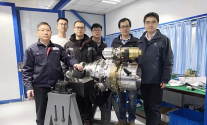You are using an out of date browser. It may not display this or other websites correctly.
You should upgrade or use an alternative browser.
You should upgrade or use an alternative browser.
Chinese Engine Development
- Thread starter jackbh
- Start date
So in the end, we didn't get any news but this mock-up model for WS-10? Any question asked by someone who was there to the presenters about WS-10? A couple of Zhuhai's ago we had 120-140 kn description for WS-10 at least.
One of the reason to keep developing WS-18 could be for future replacement for existing air-frames that use DP-30s. To certify WS-18 for that purpose, it has to be installed on a new Y-20 air-frame that is identical to the ones made for DP-30s.
So I believe that there are air-frames that are simultaneously testing WS-18 and WS-20. I think Tang Changhong actually said so not long ago that was reported in this forum.
Ofcourse, WS-18 and WS-20 would be testing on Y-20. But regarding WS-18,any further development mean that they are solely for aircrafts like H-6 series ( who service would likely extend to 2050.)
But then, isn't WS-18 supposed to be interim solutions for Y-20s ? Why try to develop it for that aircraft further? Living with the current WS-18 series and focusing on the WS-20 for Y-20 would only help China's future plans.
If true I expect the WS-19 to have a TWR of closer to 10 rather than 9.the engine thrust reached 9.5 tons (94KN), thrust to weight ratio of 8.6
In 2008, Zhao Wei joined the team of Academician Xu Jianzhong of the Institute of Engineering Thermophysics of the Chinese Academy of Sciences after graduation. Xu Jianzhong has been engaged in aero engine research for many years. At the beginning of this century, he keenly discovered that after the development of aero engines to the fourth generation, the method of increasing the pressure ratio by turning the blades has come to an end. He took a different approach and set his sights on the counter-rotating aerodynamic layout.Demonstrator for a new concept jet engine that supposedly has a thrust to weight of 12~15.
View attachment 79471
Zhao Wei recognized the shortcomings in the relevant work of the European Von Kamen Institute, combined with his own research, and proposed a multi-stage suitable for aero engines for the first time in the world. Guide vane-less counter-rotating turbine and its aerodynamic and structural coupling design method. This method can greatly reduce the weight, cost and size of the engine.
LOL. This is the water mark of the photographer.why the chinese call engine richard yip????
I was waiting for some to explore more on the "Guide Vane less Counter rotating Turbine" part. I hope the translate didn't mess up the real deal here.In 2008, Zhao Wei joined the team of Academician Xu Jianzhong of the Institute of Engineering Thermophysics of the Chinese Academy of Sciences after graduation. Xu Jianzhong has been engaged in aero engine research for many years. At the beginning of this century, he keenly discovered that after the development of aero engines to the fourth generation, the method of increasing the pressure ratio by turning the blades has come to an end. He took a different approach and set his sights on the counter-rotating aerodynamic layout.
Zhao Wei recognized the shortcomings in the relevant work of the European Von Kamen Institute, combined with his own research, and proposed a multi-stage suitable for aero engines for the first time in the world. Guide vane-less counter-rotating turbine and its aerodynamic and structural coupling design method. This method can greatly reduce the weight, cost and size of the engine.
Counter Rotating Turbines aren't new - GE 9nx has them.
No Guide Vanes aren't new - EJ200 uses them (it has rather a VGV at the first stage of HPC)
F119-F135 has counter rotating compressors (without stators) separated across two spools. ( YF120 has it too).
So what exactly is the " Guide vane-less counter-rotating turbine"?
broadsword
Brigadier
From what I gathered, counter-rotating turbine obviates the guide vanes as the rotation of the slipstream is eliminated. I am not knowledgeable enough to discuss further, but you may want to click on the links:
broadsword
Brigadier
12- 15? that is A LOT
In comparison, the P&W F135's:

